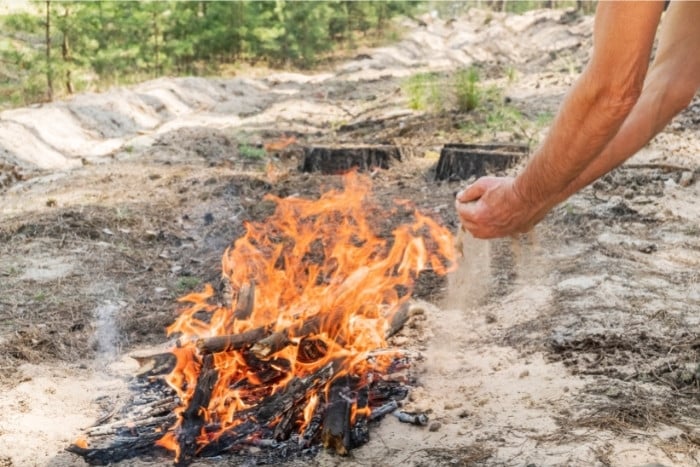Camping is an activity we generally associate with a healthy lifestyle, so it’s unusual to think such a wholesome pastime could have a sinister impact on our physical well being.
Research has shown that some tents contain chemicals that increase the risk of developing cancer. While this certainly isn’t the case for all tents, campers should know what to look for when choosing a tent that doesn’t pose a serious health risk.
By learning more about the potential health risks posed by camping, you’ll be able to avoid them entirely and guarantee your trip remains the healthy excursion it’s supposed to be.
How Is it Possible to Develop Cancer From a Camping Tent?
Below, we cover the potential causes of tent-related cancer, evidence to back it up, and how you can minimize the risk to your health and stay safe when camping.
There are a few potential ways that camping tents could cause cancer. The most likely way is if the tent is made with carcinogenic materials or treated with harmful chemicals.
If you are concerned about the potential for cancer from camping tents, there are a few things you can do to minimize the risk.
Tents Causing Cancer
The first thing you’re probably wondering is how it’s even possible for a camping tent to increase your risk of developing cancer.
We use the term carcinogen to define a substance that promotes carcinogenesis, the process through which our body’s normal, healthy cells are transformed into cancer cells.
Cell division is the way our body grows and repairs itself, and our healthy cells know when they need to stop multiplying.
If the genes responsible for regulating cell division become damaged, cells can become cancerous, meaning they continue to produce copies that can result in tumors.
In some cases, these tumors can be mostly harmless and are known as benign; however, there’s also a risk of a tumor becoming malignant, meaning cancer can spread to other body parts.
Therefore, when we discuss something that can increase our risk of developing cancer, we’re talking about whether it exposes us to carcinogens.
It’s impossible to avoid all of them.
We can do our best to limit our exposure to some of the most well-known cancer-causing agents like tobacco smoke, asbestos, UV light, and over-cooked food; however, we have to live with it and can do little to avoid it.
In many cases, something may be carcinogenic from a scientific standpoint but will have a negligible impact on our risk of developing cancer.
Ultimately, this means that when we ask whether tents can cause cancer, we ask whether tents expose us to an unhealthy quantity of carcinogens.

Can Tent Materials Cause Cancer?
The most obvious source of carcinogens in a tent would be the materials from which it’s constructed – typically, cotton, polyester, or nylon.
1. Cotton
Cotton or canvas tents have been used for centuries and are known for their durability and breathability.
They’re favored for their ability to keep their occupants cool in warmer weather and insulated from cooler weather; however, cotton tents are less common these days due to their lack of portability.
While you’re not likely to be using a cotton tent for a hiking trip, there has been a resurgence in the use of cotton tents for glamping, where portability is not considered a necessity.
If you purchase or stay in a cotton tent, there’s no reason to be concerned about carcinogens.
Cotton tents are more susceptible to mold or mildew should they get damp, but the only cotton-related carcinogenic risks that have been reported are from cotton dust.
You have nothing to worry about unless you’re a textile worker in a cotton mill with unsatisfactory health and safety regulations.
2. Polyester
Most modern tents are made from polyester: a man-made plastic fiber known for its extraordinary strength and water resistance.
Polyester tents are also far lighter than their cotton counterparts, making them far better suited for campers who need to carry their equipment with them.
If you look online, you’ll find articles claiming polyester causes cancer, but none are from reputable sources with scientific research to back them up.
Some of the chemicals used in polyester production can be extremely toxic.
However, as with cotton, unless you find yourself in a polyester manufacturing facility without the correct protective gear, you will not be in danger.
There is a point to be made regarding the sustainability of polyester due to the manufacturing process relying on fossil fuels.
Still, it won’t increase the risk of you developing cancer.
3. Nylon
The last of the three most common tent construction materials are nylon. Like polyester, nylon is another synthetic plastic fiber that offers many of the same properties.
It’s lightweight and extremely durable but less breathable than cotton. It’s water-resistant. However, it doesn’t repel water as effectively as polyester.
Nylon is more expensive than polyester as the latter can be produced in much greater quantities, but nylon’s greater strength-to-weight ratio can make it a more popular choice for tent construction.
Is nylon carcinogenic, though? No.
As with polyester, the manufacturing process of nylon involves using chemicals you wouldn’t want to come into contact with unless you were trained and protected.
Still, a nylon tent won’t increase your cancer risk.
You’ll also find plenty of blended materials that make up modern tents, whether polyester/cotton, nylon/polyester, or ultra-modern synthetic materials such as Cuben Fiber, but there’s no evidence to suggest the materials themselves pose a danger.
So if the construction material of a camping tent won’t give you cancer, what could? The answer: a flame-retardant coating.

Flame Retardants – Basics, Dangers, and Evidence
Simply put, a flame retardant is a substance that slows the rate at which a material will burn.
A material treated with a flame retardant is not fireproof but will take longer to ignite and slow the spread of fire.
Given the confined nature of a tent, it seems obvious that you’d want to minimize the risk of death or severe injury should yours catch fire, especially in an environment where naked flames are usually present.
In 1976, the Industrial Fabrics Association International (IFAI) published CPAI-84: A Specification for Flame-Resistant Materials Used in Camping Tentage.
This document provided a guideline for the acceptable limits of fire retardancy in camping tents, along with a standard system for measuring and testing the fire retardancy levels in a tent.
It’s worth noting that at the time CPAI-84 was published, polyester and nylon were nowhere near as ubiquitous in tent construction as they are today.
Both polyester and nylon can be considered naturally flame-retardant.
However, when they catch alight, severe melting and dripping occur, meaning they still pose a significant risk when aflame and are often treated with flame-retardant chemicals regardless.
Why Are Flame Retardants Dangerous?
In addition to cancer, a growing body of evidence has linked several human and animal health risks with exposure to the chemicals used in flame retardants, including adverse effects on neurological function, the endocrine system, the thyroid gland, fetal and child development, and the reproductive system.
The two types of flame retardant you’re most likely to encounter in camping tents are a form of brominated retardant: polybrominated diphenyl ethers (PBDEs) and tetrabromobisphenol A (TBBPA).
The former was first introduced around the same time CPAI-84 was produced as a way of meeting fire safety guidelines.
While most of these flame retardants have been phased out of production, the chemical can still be found in the environment and older products.
The latter, TBBPA, is the most highly produced brominated flame retardant in the world, and studies have shown exposure caused cancer in both female and male mice, in the uterus and liver, respectively.
The Evidence
The main issue with these flame retardants is that they do not bind with the products to which they’re added.
A property first explored in 2013 by an associate professor of environmental health at Duke University, Heather Stapleton.
After noticing safety warning labels on tents concerning flame retardants, Stapleton saw the perfect opportunity to take a closer look at which chemicals were being used and whether they were easily transferable from tents to people.
After noticing a line of students pitching tents to wait in line at a college basketball game, Stapleton bribed them with snacks in exchange for them allowing her to take swabs of their hands and camping equipment.
Back at her research lab, Stapleton and her team analyzed the swabs and found traces of dangerous brominated fire retardants on the students’ tents and skin.
Heather Stapleton’s initial research inspired fellow Duke University student, Genna Heath, to write her master’s thesis on the same topic she published in 2016.
Heath and Peyton Ward, her research partner, paid students to set up tents that had been treated with flame retardants in the university quad.
Once the tents had been set up, the researchers took swabs of the students’ hands and discovered the number of flame-retardant chemicals present was nearly thirty times higher than before they’d handled the tents.
They also analyzed the air inside the tent.
They discovered more flame-retardant chemicals, proving that these toxic substances were transferring too easily from the product to those handling it.

What are Tent Manufacturers Doing to Protect Campers?
When Heath and Ward’s results were made public, several tent manufacturers reacted quickly.
They decided to only sell flame retardant-free tents to reduce the risk of harming their customers.
In some cases, this even meant a loss of profits due to a few states still legally requiring manufacturers to meet the standards in CPAI-84.
In recent years, tent manufacturers have explored new flame retardant treatments.
Still, they have failed to find a chemical solution that wouldn’t pose a health risk to campers or have a detrimental environmental effect.
The consensus is that a tent without a flame-retardant coating is safer than the alternative.
Even without a flame retardant, most modern tent construction materials only miss the CPAI-84 safety parameters by a tiny margin, and manufacturers have pointed out that regulations conceived in the 1970s are no longer fit for purpose.
Furthermore, the risk of getting harmed through a tent fire is extremely low.
When research was conducted into how many tent-related injuries were linked to tent fires in the United States over five years, a mere 14 out of 16,000 were caused by tent ignition.
In Europe, only six incidents were recorded over eight years; in Australia, five incidents over six years; in Japan, one sole incident in a decade.
How to Stay Safe When Using Flame Retardant-free Tents?
Rather than a toxic flame-retardant coating, the best way to prevent your tent from catching alight is to always follow the safety tips below.
1. Pitch Your Tent Away From Fire
This may seem obvious, but the farther you pitch your tent from your campfire, the safer you’ll be.
Ten feet (three meters) is the minimum safe distance you should put between your tent and an open fire. Or think about it the other way around.
If you need to pitch your tent at a certain place due to whatever reason, then it would be wise to take your campfire somewhere else.
2. Position Your Tent Safely
Pay attention to the direction of the wind when setting up your tent relative to the location of your fire, especially if your camping spot is on the smaller side.
By pitching your tent upwind of the campfire, there’s a lower risk of kindling, sparks, or hot ash being blown onto it.
3. Keep Sources of Ignition Out of Your Tent
Any open flame inside a tent is a big no-no as it dramatically increases the chance of the fabric catching fire. This means no smoking and no cooking.
It can be tempting to cook inside the vestibule of your tent in inclement weather, but you should avoid doing so at all costs.
Our solution is to pitch a tarp over your cooking area to keep the wind and rain off.
The same goes for electric heaters – while some are made specifically for camping, our advice is to avoid them entirely.
4. Put Out Your Fire
When you’ve finished with your campfire for the night, you must extinguish it properly with water and a shovel so you can stir the ashes.
The shovel is also handy for covering the ashes in the dirt to prevent them from reigniting. We also recommend bringing a small fire extinguisher when you camp.
While you shouldn’t use this to put out your campfire, it’s extremely handy if something goes wrong.
As a general rule, if you don’t have the tools to extinguish a fire when you’ve finished with it, you shouldn’t light one in the first place.

The Verdict
The evidence shows that some tents can increase your risk of developing cancer; however, the danger comes from flame-retardant coatings rather than the construction materials themselves.
By avoiding flame-retardant tents and following the core camping fire safety tips, you can guarantee a safe camping experience.
If you’re unsure whether your current tent is fire-retardant, ensure you wear gloves when setting up and taking down your tent, and ensure the tent is well-ventilated when you’re not sleeping in it.
